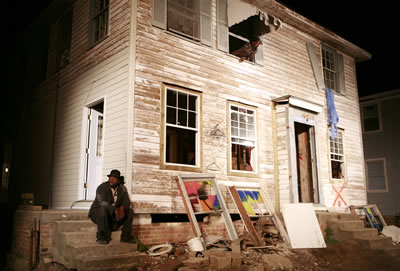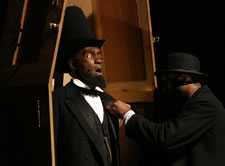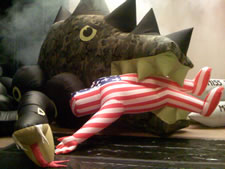 |  |  | |
 | The production of Waiting for Godot by Samuel Beckett with Paul Chan as Artistic Director, which was staged New Orleans, will be included in the USITT/USA exhibit as part of the Prague Quadrennial of Design and Space. Photo/Lee Celano | |
| PQ Selections Demonstrate ‘The Edge’ The USITT/USA curators for the 2011 Prague Quadrennial of Design and Space reviewed 360 entries that spanned stunning Broadway productions to inventive, devised work done by one passionate designer alone in her studio. Thirty-five productions will represent the United States of America in Prague in June 2011 with the theme “On the Edge.”
As opinions form about the Obama presidency, Appomattox, an opera staged by Robert Woodruff, takes the audience back to the end of the Civil War, while Bloody, Bloody Andrew Jackson, by Le Freres Corbusier, presents the opinion that America was and is a troublemaking teenager in the world. In Fondly do we Hope…Fervently do we Pray, Bill T. Jones envisions “the America that might have been had Lincoln completed the Reconstruction.” Always conscience-prodding, Ping Chong reminds, through voices from marginalized communities, that there are Undesirable Elements in the melting pot, and the Broadway production of American Idiot unrelentingly pushes America’s “wasted youth” into our faces questioning who the American idiot really is. Three plays showing Americans grappling with the Bush years are: Waiting for Godot, boldly placed in the streets of New Orleans, in the devastated Lower Ninth Ward and the front yard of an abandoned house in Gentilly (by Paul Chan after the production concept of Troy Hourie for Classical Theatre of Harlem); Love Unpunished by Pig Iron Theatre -- a resolutely apolitical attempt to reclaim the humanity of the dead and to raise the possibility of community in 9/11-era America; and Surrender by the International Wow Company which “simulated the training, deployment to Iraq, and return of a platoon of soldiers enacted by the audience. Upon arrival, the audience was issued boots, a uniform and a replica M-4 rifle.” Desire Under the Elms and Aida re-envision classics in ways that are utterly surprising. Desire Under the Elms, directed by Robert Falls, “took place in a rocky New England setting with the house that protagonists fight for suspended high in the air out of everybody’s reach.” Led by stage director Christopher Alden, the Aida team created “a site specific production as Berlin itself was the protagonist, physically represented…. by fine, slick modern architecture that self consciously evokes the historical and traditional Berlin.” The U.S. exhibition structure will become a space where projection and interactive media will take over at times, and pieces such as Builder’s Association’s Continuous City, Fatebook from New Paradise Labs, Fire Island by 3 Legged Dog, and Screen Test by Rob Roth will change the space from an exhibit to an event as American directors and designers grapple with a love/hate relationship with technology and truth. Some stunning works by theatre artists will push questions of existence such as those by Elizabeth Streb of Streb Extreme Action, where performers seem to defy gravity and death with every move, and David Kaplan in The Day on Which a Man Dies. The latter play was written by Tennessee Williams as a new form beyond naturalism and was kept in reserve until 2008, as the playwright intended. It is about Jackson Pollack and the artist’s consciousness split between creation and destruction. On a lighter note, cross-dressing performance artist Joey Arias and brilliant puppet master Basil Twist have teamed to create Arias with a Twist, a “docu-fantasy” about each of their careers. “These two national treasures unleash their epic imaginations to conjure both a modern and intimate fantasy.”
The curators are profoundly grateful for the remarkable interest shown for this major international celebration of design for performance. Start planning now to travel to Prague and see the United States and more than 55 other country's exhibitions in person. PQ11 runs from June 16 to 26, 2011 . The National, Student, and Architecture exhibits for PQ11 will be housed in the Veletrzni Palace, Prague, Czech Republic. For a complete listing of the productions invited to be shown in the USITT-USA Exhibit, go to 2011exhibit.usitt.org/home.php/Submissions. Tasked with a socio-political theme that is at once self-reflective and self-critical, the job of choosing fewer than 40 productions was difficult. Many reviews were needed to make the final decisions. As though called to action by Samuel Beckett with consciences bared, the curators for the U.S. National Exhibit debated themes central to the exhibition and wrestled with the many fine production submissions, before completing the selection process in May. The Edge refers to the brave and dangerous edge of creation, but also refers to the United States as a country on edge. Note: Descriptions of the plays are excerpted from the submissions, websites, and reviews of the accepted groups. |  | |
 Two productions speaking to that are Apollo and The American Play. Director/designer Nancy Keystone takes the pulse of U.S. social and political consciousness told through history. Apollo probes the questions: what was sacrificed to become today’s America? And was it worth it?
Two productions speaking to that are Apollo and The American Play. Director/designer Nancy Keystone takes the pulse of U.S. social and political consciousness told through history. Apollo probes the questions: what was sacrificed to become today’s America? And was it worth it?  Live performance that touches on all the exhibit’s themes, including the destruction of the planet, will be provided by punning costume activist, Pat Oleszko and puppeteering political satirist, Paul Zaloom. Warosaurus, one of Oleszko’s inflatable series from Airtopia, will hang above the U.S. Exhibition site to greet viewers as they enter the space, as a reminder that great work in the United States often comes from modest places.
Live performance that touches on all the exhibit’s themes, including the destruction of the planet, will be provided by punning costume activist, Pat Oleszko and puppeteering political satirist, Paul Zaloom. Warosaurus, one of Oleszko’s inflatable series from Airtopia, will hang above the U.S. Exhibition site to greet viewers as they enter the space, as a reminder that great work in the United States often comes from modest places.